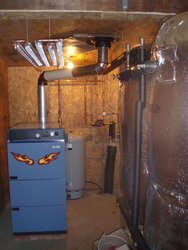yesterday I had the pleasure of performing the first burn in my new Tarm Solo Innova 50 w/ 800 gallons of pressurized storage.
After several hours I started to bring the whole system up to temp. and was a little lax in bleeding some h20 every now and then....Thus my old boiler (propane) was overcome (in a pressure sense) and dropped a few gallons on h20 on the floor....No big deal just thought I share so other news can learn from my mistake.....Bottom line is when you heat ALOT of water it gets bigger......I'm on day 2 and starting to feel like things are stabilizing absit.....
Best,
Rob "not so stayalert?" M
Norwich, VT
After several hours I started to bring the whole system up to temp. and was a little lax in bleeding some h20 every now and then....Thus my old boiler (propane) was overcome (in a pressure sense) and dropped a few gallons on h20 on the floor....No big deal just thought I share so other news can learn from my mistake.....Bottom line is when you heat ALOT of water it gets bigger......I'm on day 2 and starting to feel like things are stabilizing absit.....
Best,
Rob "not so stayalert?" M
Norwich, VT


